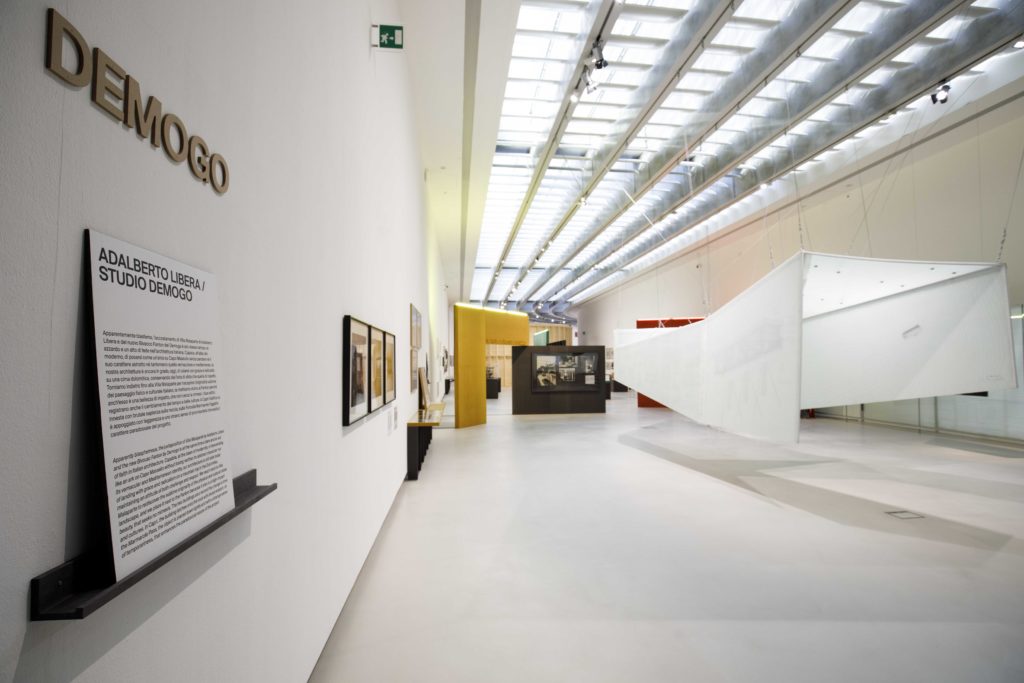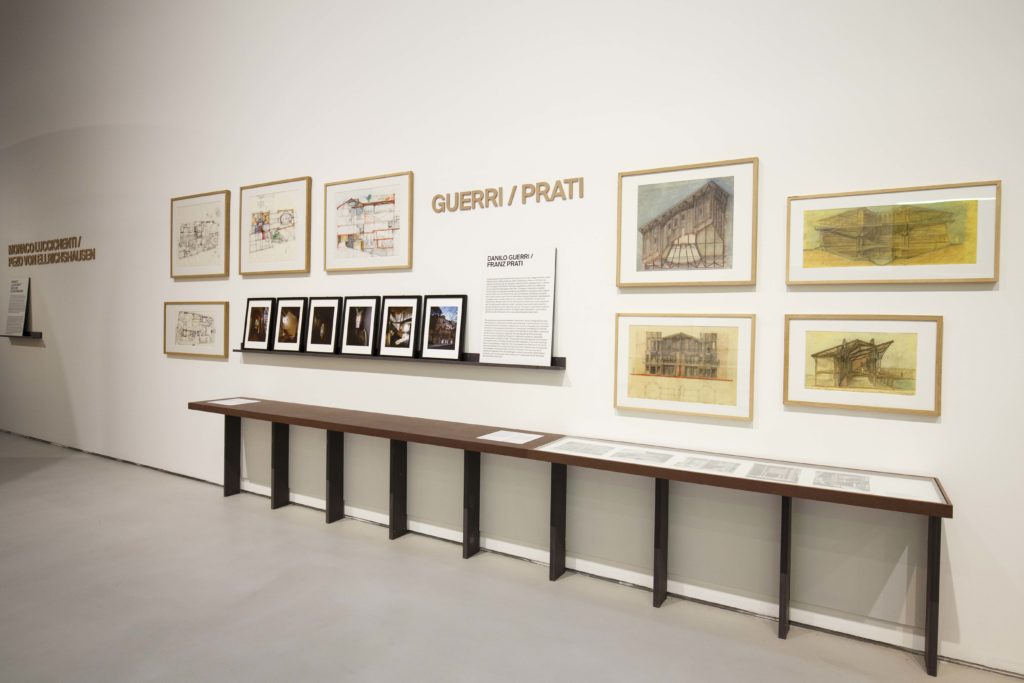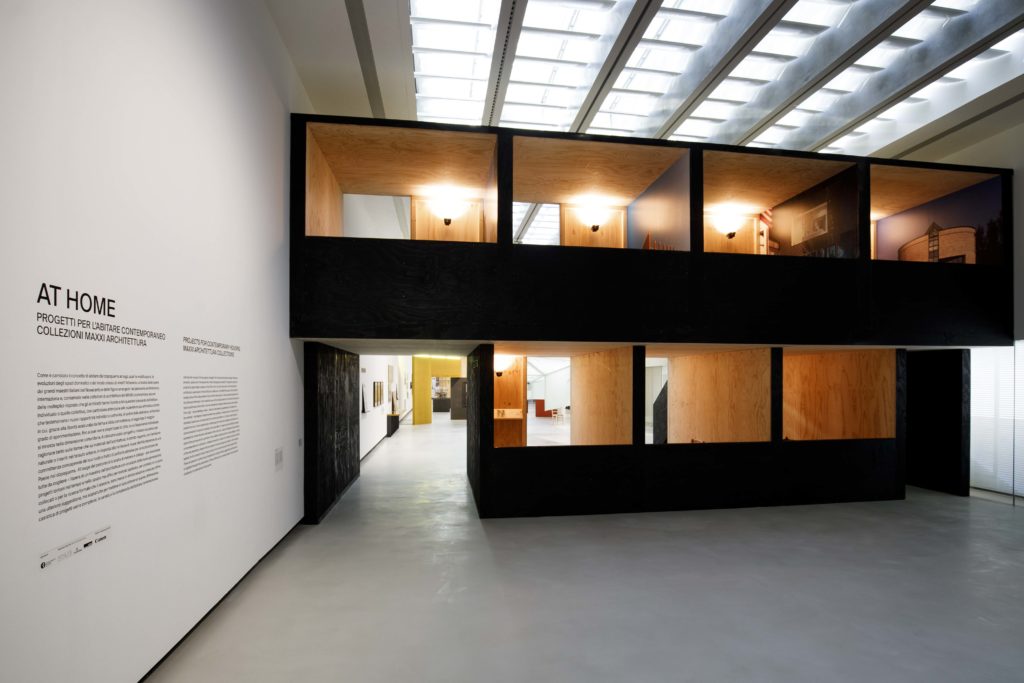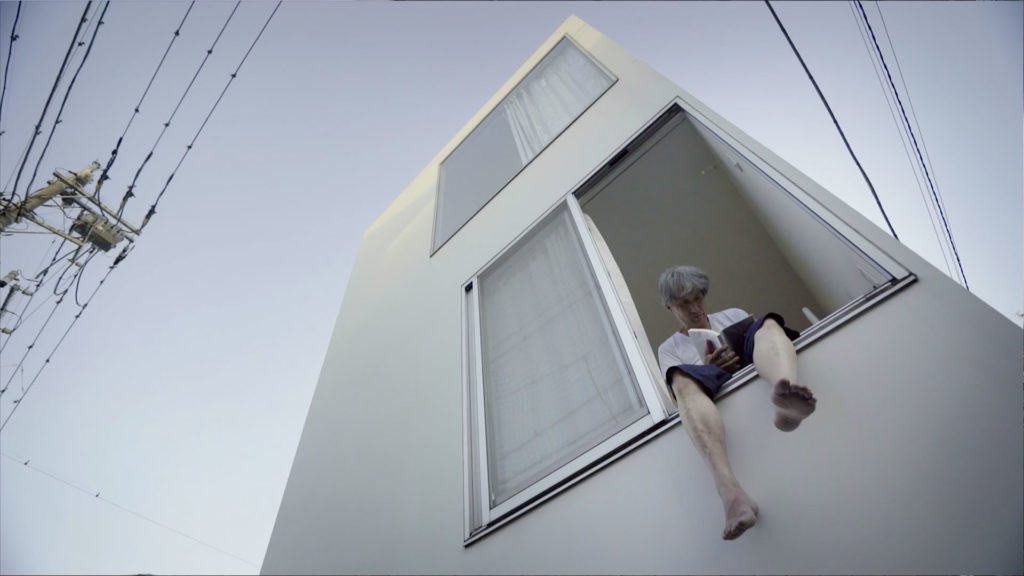exhibition
17 April 2019 > 01 November 2020
valid until 9 April due to the Museum’s first-floor closing
buy online
the only open ticket, valid for 100 years, for one admission to the Museum and all current exhibitions
buy online
valid for access to the Museum during the last opening hour, available online and at the Museum’s digital ticket point only
upon presentation of the membership Card or Carta EFFE
buy online
minors under 18 years of age; disabled people requiring companion; EU Disability Card holders and accompanying person; MiC employees; European Union tour guides and tour guides, licensed (ref. Circular n.20/2016 DG-Museums); 1 teacher for every 10 students; ICOM members; AMACI members; journalists (who can prove their business activity); myMAXXI membership cardholders; European Union students and university researchers in Art and Architecture, public fine arts academies (AFAM registered) students and Temple University Rome Campus students from Tuesday to Friday (excluding holidays); IED – Istituto Europeo di Design professors, NABA – Nuova Accademia di Belle Arti professors, RUFA – Rome University of Fine Arts professors; upon presentation of ID card or badge – valid for two: Collezione Peggy Guggenheim a Venezia, Castello di Rivoli Museo d’Arte Contemporanea, Sotheby’s Preferred, MEP – Maison Européenne de la Photographie; on your birthday presenting an identity document
for groups of 12 people in the same tour; myMAXXI membership card-holders; registered journalists with valid ID
buy online
under 14 years of age
buy online
disabled people + possible accompanying person; minors under 3 years of age (ticket not required)
book online
MAXXI’s Collection of Art and Architecture represents the founding element of the museum and defines its identity. Since October 2015, it has been on display with different arrangements of works.


Foto ©Musacchio, Ianniello & Pasqualini
Apparently blasphemous, the juxtaposition of Villa Malaparte by Adalberto Libera and the new Bivouac Fanton by Demogo is at the same time a dare and an act of faith in Italian architecture. Capable, at the dawn of modernity, of descending like an ark on Capo Massello without losing neither its abstract character nor its vernacular and Mediterranean identity, our architecture is still capable today of landing with grace and radicalism on a mountain top in the Dolomites, maintaining an attitude of both challenge and respect. We reach back to Villa Malaparte to rediscover the sublime originality of the physical and cultural Italian landscape, and we place it next to the Fanton because it also is a high-impact beauty, that seeks no mimesis. The two buildings also record the change in time and cultures. In Capri, the building latches onto the rock with brutal wisdom; on the Marmarole Pass, the object is placed down lightly and with a strange sense of temporariness, that enhances the paradoxical nature of the project.

Foto ©Musacchio, Ianniello & Pasqualini
Can Carlo Scarpa come to mind when looking at projects by Maria Giuseppina Grasso Cannizzo? Under many aspects, the two couldn’t be more distant: Veneto against Sicily, infinite detail against austere precision in the approach, poetics of the fragment against a proud sense of formal and expressive unity. However, they also have much in common: the individual nature of their research, a passion for materials and their specific qualities, the many – but not necessarily looked for – occasions to work on a small scale, closeness with art, the ability to “design” their own clients, the distant echo of Japanese accuracy. As some of Scarpa’s creations, the house in Modica is a work of art in its fullest sense, imagined together with its bold construction method and the effect it would have on the landscape and its inhabitants. As always, what strikes us is the amplitude of Grasso Cannizzo’s design language, as technical as an engineer, as synthetic and visionary as an abstract artist.

Roma, Museo del Maxxi, 17 04 2019 OPENING MOSTRA AT HOME ©Musacchio, Ianniello & Pasqualini
Luigi Pellegrin and Giuseppe Perugini are two heroes of the wildest and most interesting phase of Italian architecture. With constant support by Bruno Zevi, they were both tireless creators of projects directed towards a technical and social future, intolerant towards “paper” utopias. They both had a penchant for the public or even monumental dimension, made up of schools, public buildings, large complexes. It is therefore interesting to see them here self-commissioned and “forced” to a domestic dimension, while they try to empty the architecture of the house of any intimate aspect to transform it into a purely spatial archetype. In his semi-detached family villa, Pellegrin uses the building plan as if it were one of his memorable sections, he makes it burst and imagines it at the centre of an in nitely dynamic perspective spatial system. The Perugini family’s Casa Albero – another “house like me” – is built as an organic structure to which individual cells containing domestic spaces are added, as in a cellular organism with unlimited growth.

Foto ©Musacchio, Ianniello & Pasqualini
The dialogue between the Pitch House by RICA Studio and the Italian Embassy by Pier Luigi Nervi in Brasilia unfolds along the lines that have always connected the modernity of Italian and Spanish architecture: the ostentation of concrete mitigated by a Mediterranean character, the ability to “handle” the light, the structural clarity, obvious for Nervi, sophisticated in the superimposition of a heavy volume on a lightweight frame for RICA. There is also a topological assonance: both buildings have two levels, long concrete fronts of public nature, a permeable and transparent ground floor. The Embassy accepts Brasilia’s hyper-modernist challenge and falls in line with South American structural heroism, rising and transforming the pilotis into conspicuous clustered pillars. The residence, offices and reception rooms occupy the raised floor, while the landscape enters the space between the pillars creating the image of a garden. The Pitch House instead collects itself within a completely built space, absorbing the landscape through its large windows, the swimming pool and the verandahs that protrude toward the coast. These are two generous spaces, that question the less private aspects of living spaces.

Foto ©Musacchio, Ianniello & Pasqualini
Roman Baroque is among the architectural passions that Zaha Hadid often mentioned, wit its ability to sculpt the urban space, its unique blend of solidity and lightness. Her project for the MAXXI is perhaps the most explicit testimonial to this passion, which is however also present in her later work and in her firm’s current projects. It in fact appears in the house built near Moscow, in the characteristic way in which the dynamic development of curved shapes is interwoven with the sudden changes in altitude and height. It is unavoidable to travel back in time and place this project designed by Hadid’s office beside the first successful tribute to Baroque tradition, namely Casa Baldi by Paolo Portoghesi, creative in its form and spaces, traditional in materials. The connection between the two architects becomes clearer if we consider the second – unbuilt – project for the same house: slender in height, hyperdynamic, enriched by a complex series of rotations and vertical spatial joints.

Foto ©Musacchio, Ianniello & Pasqualini
The assonance we perceive between Franz Prati’s house in Reggio Emilia and Danilo Guerri’s in Recanati is subtle and interesting. It can be traced in a similar passion for ancient materials, notably bricks, in a sort of vaguely rural chromatic familiarity, in their absolute dedication to the strength of drawing. For Prati, the drawing is of course the central aspect of his identity as an architect, a semantic platform where the author draws out not only everything that will actually be built, but also everything that will not: alternative solutions, impossible developments, changes of heart. The project is thus the decisive joint between the realism of the completed building and the radicalism of the initial drawings. Guerri is also always in search of “the most beautiful architecture in the world”, which according to him arises from the summation of details that are designed and changed a thousand times, from the “improper” and authorial use of traditional materials, from the challenge to almost impossible morphological contexts, such as the slope of the “solitary hill” in Recanati, which the house descends floor after floor.

Foto ©Musacchio, Ianniello & Pasqualini
The President’s Villa del Gombo is an atypical project for Monaco and Luccichenti. Sublime designers of buildings, offices, airports, the two Roman designers are here confronted with the villa typology and with a pure and simple architectural form, the square, here raised and empty at its centre. The authors focus all their attention on a minimal geometrical shape with a modern vision of the relationship between architectural body, ground, history and landscape. Similarly, the Guna House designed by the Chilean firm, although smaller, built into a more compressed lot conditioned by sloping and trees, insists on the same geometric principle. It is distributed in regular spaces around the sides of a square patio, this time at the same height of the rooms, and resting on a podium as large as the central court. The difference lies mostly in the relationship with the surrounding areas: open and at in Tuscany, while sloped and crowded in the south of Chile; and in the consequent use of materials: lighter and transparent for Villa del Gombo, solid and protective for Guna House.

Foto ©Musacchio, Ianniello & Pasqualini
In his last project in Berlin, on Schützenstrasse, Aldo Rossi translated his love for Berlin and its city blocks into a mature and disenchanted project, where the façades of the block are fragmented into a sequence of small independent fronts. Their dimensions do not correspond to the block’s internal organization, their language tells of different ages and moments, their appearance does not necessarily translate into structural reality. At the end of his career, Rossi nally gives in to irony and hides, among the other fragments of façade, a span taken from Palazzo Farnese’s façade. Less ironic but equally curious about history, Urbanus the Chinese architects of the Vankle Tulou Housing are faced with having to build the city rather than integrate it, and take direct inspiration from the astonishing historical building type from southern China, the hakka houses. These are large circular complexes with a central space occupied by the common spaces and lower constructions, and where the family expands and branches out to become community.

Foto ©Musacchio, Ianniello & Pasqualini
The juxtaposition of Giancarlo De Carlo and David Adjaye is motivated by a certain design attitude that the two architects share. For both of them, architecture is the patient research for a balance between a pure passion for form and the needs of those who will inhabit these spaces and give them their final identity. De Carlo builds his Urbino by superimposing the routes and the dynamics of today’s residents – students, architecture tourists, his friend Sichirollo – onto the historic city. With Sugar Hill, Adjaye builds in the heart of New York’s accelerated capitalism a perfect example of post-modern welfare, based not only on the granting of spaces and services, but inserted – similar in this to De Carlo’s Urbino – in a context of culture and education. Both refuse the “dictatorship of the ground line”, they pierce through floors and sections to distribute movement and light. They both have an “enlightened” confidence in the power of architecture and education.

Foto ©Musacchio, Ianniello & Pasqualini
Francesco Berarducci’s villino and this typology itself are true expression of the history of architecture and urban planning in Rome during the post war period. The architectural type of the small villa – three floors and a surrounding garden – has here been stretched in length and width, adapted to a slope, redeemed with such a wealth of volumetric complexity, of materials and details, of internal organization, that it is transformed into an almost ideal building. Jo Noero, along the same longitude but in the opposite hemisphere, and belonging to a very distant architectural culture, also seems committed to defining a new type of urban residential building, high rise (12 oors) and organized as a suburban slab block, but shorter, with a façade whose measures are more in line with a city centre. Despite the distance of space and time, the two projects share an absolute trust in the drawing as a regulator of relations between the building, the landscape, the city and the life that takes place within them.

Foto © Moriyama San - Ila Bêka, Louise Lemoine
In the developing dialectic between individual homes and collective housing, the Vertical Forest by Stefano Boeri and the Moriyama House by Ryue Nishizawa both occupy an intermediate position, where architectural types and life styles are confused but also represent an essential part of the building’s identity. More than an apartment tower, Boeri’s building aspires to be a superimposition of villas, each one with its own garden. It is the superimposed villas imagined by Le Corbusier, here translated into an environmentalist icon for Milan. The Moriyama House is a small Japanese miracle, a portrait-home for one single inhabitant that turns without jolts into a mini-neighbourhood of small isolated houses, where each room, separated from the others, can be transformed into an independent unit, available for short-term lets. The building designed by Studio Boeri ideally reunites the city within itself, with an idealized ratio between building, sky and vegetation. In Tokyo the house explodes to become city, regardless to whether it is inhabited by a single individual or by a collage of temporary residents.

Foto ©Musacchio, Ianniello & Pasqualini
For many years Corviale by Mario Fiorentino has been not only a building: it is a theme of urban sociology, a useful topic in cultural, political and aesthetic battles, a device of artistic production and one of the few completed symbols of the Italian way to social utopia, a crucial theme of the 1960s research on housing. Lately, however Corviale has also become a paradigm – a borderline case and at the same time a standard – of the urgency and potential of Italian suburban residential buildings, and not only. Beyond loving or hating it, the kilometre-long building may perhaps be regenerated, recycled, completed, “revived”, newly contextualized. The sense of urgency that comes from the sum of its physical size and of its many problems has thus given rise to regeneration projects and programs. Those by Laura Peretti for the rethinking of the spaces of relationship and by Guendalina Salimei for the liberation of the fourth floor, here on dispaly, fuel not only hopes of renewal for the residents and the city but also provide interesting elements for a debate that involves most European cities, regarding the future of large modernist residential neighbourhoods, fascinating but obsolete remains of a past welfare system, that we must somehow incorporate into contemporary space.

As part of the activities of the Future Architecture European network, MAXXI has asked five videomakers selected through an open call to produce architectural videos addressing issues related to the relationship between the pandemic and inhabited space. During an online workshop that lasted the entire month of June, the authors produced works focused on domestic isolation, the impact of lockdown on emotional and social relationships and the disturbing role played by public space in the hot months of the pandemic.
Watch some extracts on YouTube.
___
in collaboration with Copenhagen Architecture Festival
part of Future Architecture
co-funded by Programma Creative Europe dell’Unione Europea
galleria 2
a cura di Margherita Guccione, Pippo Ciorra
La mostra riapre al pubblico dal 18 giugno 2020 con un nuovo focus sulla casa post COVID-19
La celebre Villa Malaparte a Capri in dialogo con il rifugio sulle Dolomiti dei giovani DEMOGO; i Collegi universitari di Urbino di Giancarlo De Carlo con il progetto Sugar Hill di David Adjaye, ad Harlem; la Casa Baldi di Paolo Portoghesi a Roma con la casa “spaziale” di Zaha Hadid in Russia; Il Bosco Verticale di Stefano Boeri, a Milano con la Moryama House di Tokyo; la casa del film Indagine su un cittadino al di sopra di ogni sospetto di Francesco Berarducci a Roma con un edifico progettato a Johannesburg da Jo Noero.
Sono alcuni dei duetti di AT HOME 20.20 Progetti per l’abitare contemporaneo, il nuovo allestimento della collezione di architettura del Museo, che racconta l’evoluzione del concetto di abitare dal dopoguerra a oggi, analizzato attraverso le opere dei grandi maestri del Novecento e delle nuove figure emergenti del panorama architettonico internazionale e rivisto, nella nuova versione 20.20, alla luce di come il Coronavirus abbia cambiato il nostro modo di vivere la casa.
Il progetto di allestimento punta inoltre a raccontare l’architettura anche attraverso una esperienza fisica e immersiva del visitatore con una serie di grandi installazioni in scala reale e padiglioni realizzati site specific da architetti italiani e internazionali.
Questa nuova versione si arricchisce di una sorta di “mostra nella mostra”, con opere di architettura e design, documenti, interviste, progetti video e un articolato programma di film screening. In mostra le voci e i volti di grandi architetti, quali Paolo Portoghesi, David Adjaye, Patrik Schumacher dello Studio Hadid e Maria Giuseppina Grasso Cannizzo che, in una serie di video-selfie, espongono idee, stati d’animo e riflessioni sull’impatto della pandemia sulla loro professione. Al design è affidato il racconto della natura flessibile e multiuso dello spazio domestico, con lavori di Achille e Pier Giacomo Castiglioni, Ettore Sottsass, Joe Colombo, Bruno Munari, Verner Panton, insieme alle proposte più recenti stimolate dal lockdown.
DEMOGO, Bivacco Fanton, Dolomiti (BL), 2015. Ph. Pietro Savorelli
SECTIONS
LIBERA/DEMOGO
SCARPA/GRASSO CANNIZZO
PERUGINI/PELLEGRINI
NERVI/RICA
PORTOGHESI/HADID
GUERRI/PRATI
MONACO LUCCICHENTI/PEZO VON ELLRICHSHAUSEN
ROSSI/URBANUS
DE CARLO/ADJAYE
BERARDUCCI/NOERO
BOERI/NISHIZAWA
IL CORVIALE
Architecture Film Summer School